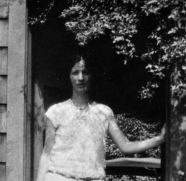Louise Bogan facts for kids
Quick facts for kids
Louise Bogan
|
|
|---|---|
 |
|
| Born | August 11, 1897 Livermore Falls, Maine, United States |
| Died | February 4, 1970 (aged 72) New York City, New York, US |
| Occupation | Poet, critic |
| Alma mater | Boston University |
Louise Bogan (born August 11, 1897 – died February 4, 1970) was an important American poet. She made history in 1945 by becoming the first woman to be named the United States Poet Laureate for the Library of Congress. Throughout her life, she wrote many poems, stories, and critical reviews. She also became the regular poetry reviewer for The New Yorker magazine.
A writer named Brett C. Millier called her "one of the finest lyric poets America has produced." He noted that because she was a woman and preferred traditional poetry styles, her work was sometimes not fully appreciated until recently.
Contents
Early Life and Education
Louise Bogan was born in Livermore Falls, Maine. A kind person helped her attend Girls' Latin School for five years. This is where she started writing poetry and reading early copies of Poetry: A Magazine of Verse. Her good education allowed her to attend Boston University. However, she left the university after her first year in 1916.
Moving to New York
Bogan moved to New York City to become a writer. Her only daughter, Maidie Alexander, stayed with Bogan's parents. In 1920, Louise spent a few years in Vienna. There, she wrote poems about feeling lonely and finding her new self.
She later returned to New York City. In 1923, she published her first book of poems, Body of This Death: Poems. Four years later, her second book, Dark Summer: Poems, came out. Soon after, she started working as a poetry editor for The New Yorker. During this time, she met many famous writers like William Carlos Williams and Marianne Moore.
A Career in Poetry
Louise Bogan wrote six collections of poetry. Some of her well-known books include Body of This Death (1923), Collected Poems: 1923–1953 (1954), and The Blue Estuaries: Poems, 1923–1968 (1968). She also wrote several books of prose (regular writing, not poetry) and translated works from other languages.
Awards and Recognition
Bogan received many important awards for her work. She earned two fellowships from the Guggenheim Foundation. In 1955, she won the Bollingen Prize from Yale University. She also received money awards from the Academy of American Poets and the National Endowment for the Arts. In 1945, she was chosen to be the Consultant in Poetry to the Library of Congress. This role is now known as the Poet Laureate.
It was often hard to be a female poet in the 1930s and 1940s. Louise Bogan also came from a working-class background and had limited formal education. She even said that it was difficult for one woman poet to review another, especially if the review wasn't positive.
Later Works and Reviews
Bogan's poetry appeared in famous magazines like The New Republic, The Nation, and Poetry: A Magazine of Verse. Her book Collected Poems: 1923–1953 won the Bollingen award in 1955. She also received an award from the Academy of American Poets in 1959.
She was the poetry reviewer for The New Yorker from 1931 until she retired in 1970, shortly before she passed away. She once said about retiring, "No more pronouncements on lousy verse. No more hidden competition. No more struggling not to be a square."
Legacy
After her death, some of her personal writings were published in a book called Journey around My Room (1980). Elizabeth Frank wrote a biography about Louise Bogan, Louise Bogan: A Portrait, which won a Pulitzer Prize in 1986. Her work continues to inspire new art, like Ruth Anderson's sound poem I Come Out of Your Sleep, which uses sounds from Bogan's poem "Little Lobelia."

